Wildlife advocate, primate expert Jane Goodall dies at 91
She upended scientific norms of the time, giving chimpanzees names instead of numbers, observing their distinct personalities, and incorporating their family relationships and emotions into her work.
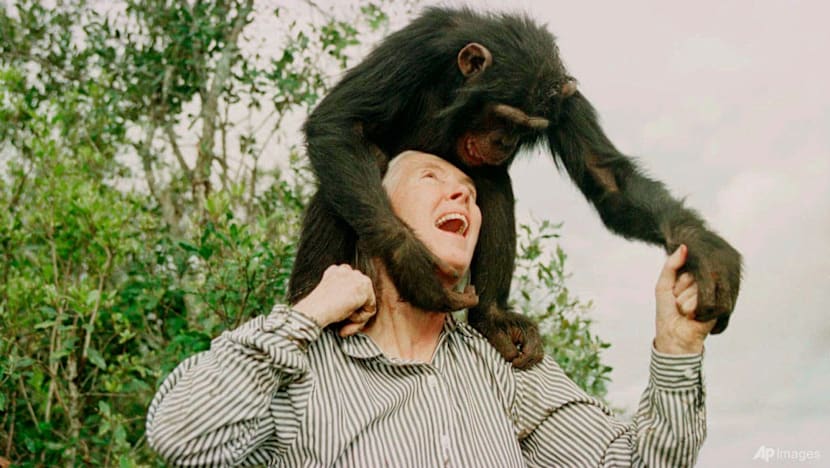
Jane Goodall plays with Bahati, a three-year-old female chimpanzee, at the Sweetwaters Chimpanzee Sanctuary near Nanyuki, north of Nairobi, on Dec 6, 1997. (Photo: AP/Jean-Marc Bouju)
WASHINGTON: British primatologist Jane Goodall, who transformed the study of chimpanzees and became one of the world's most revered wildlife advocates, has died at the age of 91, her institute announced Wednesday (Oct 1).
Goodall "died peacefully in her sleep while in Los Angeles" on a speaking tour of the United States, the Jane Goodall Institute said in a statement on Instagram.
"Dr Goodall’s discoveries as an ethologist revolutionised science, and she was a tireless advocate for the protection and restoration of our natural world," it said.
Goodall had been scheduled to meet with students and teachers on Wednesday to launch the planting of 5,000 trees around wildfire burn zones in the Los Angeles area.
Organisers learned of her death as the event was to begin at EF Academy in Pasadena, said spokesperson Shawna Marino. The first tree was planted in Goodall’s name after a moment of silence.
“I don’t think there’s any better way to honour her legacy than having a thousand children gathered for her,” Marino said.
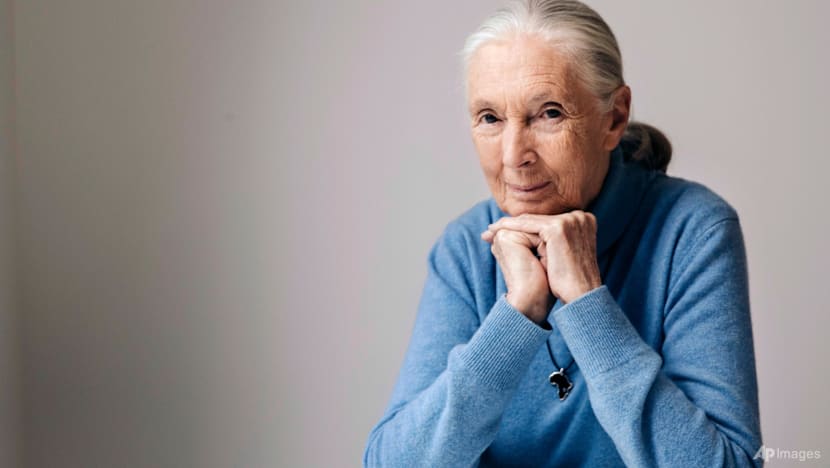
PIONEER
The primatologist-turned-conservationist spun her love of wildlife into a lifelong campaign that took her from a seaside English village to Africa and then across the globe in a quest to better understand chimpanzees, as well as the role that humans play in safeguarding their habitat and the planet's health overall.
Goodall was a pioneer in her field, both as a female scientist in the 1960s and for her work studying the behaviour of primates. She created a path for a string of other women to follow suit.
She also drew the public into the wild, partnering with the National Geographic Society to bring her beloved chimps into their lives through film, TV and magazines.
She upended scientific norms of the time, giving chimpanzees names instead of numbers, observing their distinct personalities, and incorporating their family relationships and emotions into her work. She also found that, like humans, they use tools.
"We have found that after all there isn't a sharp line dividing humans from the rest of the animal kingdom," she said in a 2002 TED Talk.
As her career evolved, she shifted her focus from primatology to climate advocacy after witnessing widespread habitat devastation, urging the world to take quick and urgent action on climate change.
"We're forgetting that we're part of the natural world," she told CNN in 2020. "There's still a window of time."
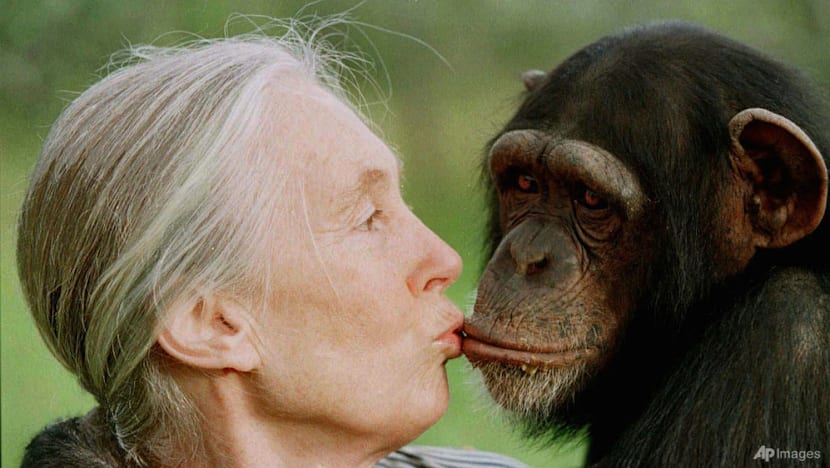
TRANSFORMATIVE DISCOVERIES
Born in London on Apr 3, 1934 and then growing up in Bournemouth on England's south coast, Goodall grew fascinated with animals in her early childhood when her father gave her a stuffed toy chimpanzee that she kept for life. She devoured Tarzan books, about a boy raised by apes who falls in love with a woman named Jane.
She set her dreams aside after leaving school, unable to afford university. She worked as a secretary and then for a film company until a friend's invitation to visit Kenya put the jungle - and its inhabitants - within reach.
In 1957, she travelled to Kenya and began working for the renowned palaeoanthropologist Louis Leakey, who dispatched her to study chimpanzees in Tanzania. She became the first of three women he chose to study great apes in the wild, alongside American Dian Fossey and Canadian Birute Galdikas.
Goodall's most famous finding was that chimpanzees use grass stalks and twigs as tools to fish termites from their mounds.
Leakey urged her to pursue a doctorate at Cambridge University, where she became only the eighth person ever to earn a PhD without an undergraduate degree.
Goodall also revealed chimpanzees' capacity for violence - from infanticide to long-running territorial wars - challenging the belief that our closest cousins were inherently gentler than humans.
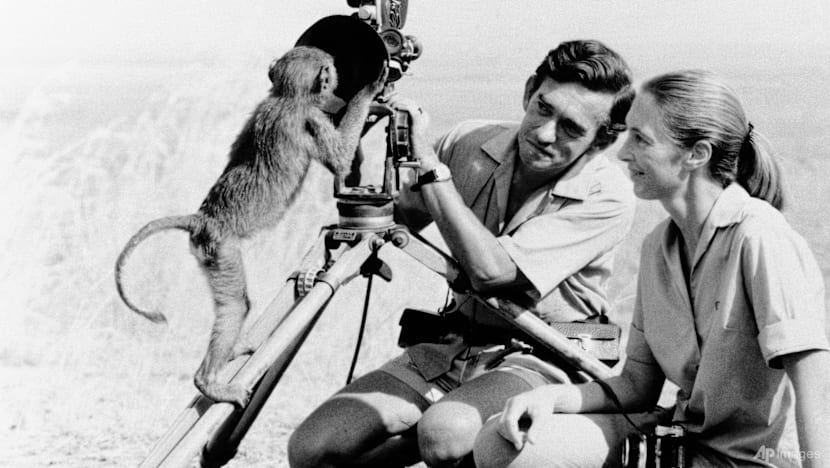
"EXTRAORDINARY LEGACY"
Tributes poured in from conservationists, politicians and entertainers.
"I'm deeply saddened to learn about the passing of Jane Goodall, our dear Messenger of Peace," said UN chief Antonio Guterres. "She is leaving an extraordinary legacy for humanity & our planet."
"Renowned zoologist, primatologist, researcher and a friend of Tanzania, Dr Goodall's pioneering work at Gombe National Park transformed wildlife conservation, and placed our country at the heart of global efforts to protect chimpanzees and nature," said Tanzanian President Samia Suluhu Hassan.
"I think the best way we can honour her life is to treat the earth and all its beings like our family, with love and respect," said actress Jane Fonda, herself an environmental activist. "I loved her very much."
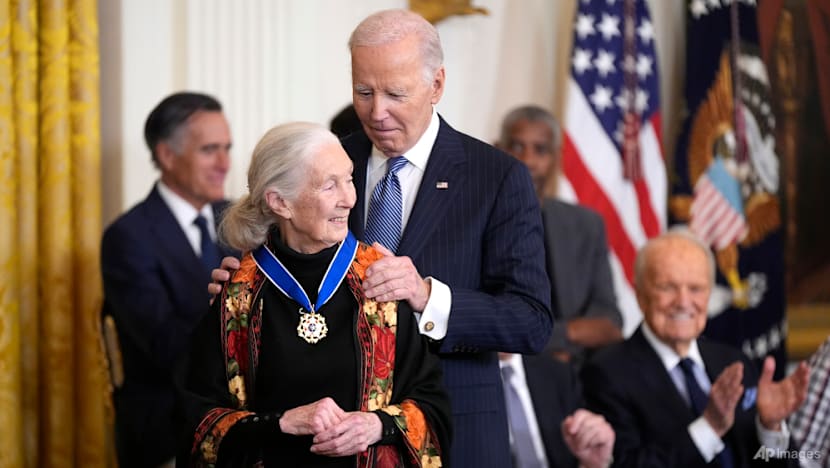
MESSAGE OF EMPOWERMENT
Goodall wrote dozens of books, appeared in documentaries, and earned numerous honours, among them being made a Dame Commander by Britain and receiving the US Presidential Medal of Freedom from then-president Joe Biden.
She was also immortalised as both a Lego figure and a Barbie doll, and was famously referenced in a Gary Larson cartoon depicting two chimps grooming.
"Conducting a little more 'research' with that Jane Goodall tramp?" one chimp asks the other, after finding blonde hair. Her institute had its lawyers draft a threatening letter, but Goodall herself waved them off, saying she found it amusing.
"The time for words and false promises is past if we want to save the planet," she told AFP in an interview last year.
Her message was also one of empowerment.
"Each individual has a role to play, and every one of us makes some impact on the planet every single day, and we can choose what sort of impact we make."
Goodall said she never doubted the planet's resilience or human ability to overcome environmental challenges.
"Yes, there is hope ... It's in our hands, it's in your hands and my hands and those of our children. It's really up to us," she said in 2002, urging people to "leave the lightest possible ecological footprints."

Nearly thirty years after first arriving in Africa, however, Goodall said she realised she could not support or protect the chimpanzees without addressing the dire disappearance of their habitat. She said she realised she would have to look beyond Gombe, leave the jungle, and take up a larger global role as a conservationist.
In 1977, she founded the Jane Goodall Institute to further research and conservation of chimpanzees. In 1991, she launched Roots & Shoots, a youth-led environmental program that today operates in more than 60 countries.
Her activism was sparked in the 1980s after attending a US conference on chimpanzees, where she learned of the threats they faced - exploitation in medical research, hunting for bushmeat, and widespread habitat destruction.
From then on, she became a relentless advocate for wildlife, travelling the globe into her nineties.
Goodall married twice. First to Dutch nobleman and wildlife photographer Baron Hugo van Lawick, with whom she had her only child, Hugo Eric Louis van Lawick, who survives her.
That marriage ended in divorce and was followed by a second, to Tanzanian lawmaker Derek Bryceson, who later died of cancer.












